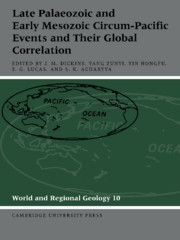Book contents
- Frontmatter
- Contents
- List of contributors
- Preface
- 1 Major global change: framework for the modern world
- 2 Carboniferous-to-Triassic evolution of the Panthalassan margin in southern South America
- 3 Permian and Triassic geologic events in Sonora, northwestern Mexico
- 4 Advances in the correlation of the Permian
- 5 Examples of late Hercynian transtensional tectonics in the Southern Alps (Italy)
- 6 Succession of selected bioevents in the continental Permian of the Southern Alps (Italy): improvements in intrabasinal and interregional correlations
- 7 Permian chronostratigraphic subdivisions and events in China
- 8 Indosinian Tectogeny in the geological correlation of Vietnam and adjacent regions
- 9 Sitsa flora from the Permian of South Primorye
- 10 Late Permian bimodal volcanism in South Primorye
- 11 Syngenetic and epigenetic mineral deposits in Permian and Triassic sequences of the Primorye region
- 12 The mid-Permian: major changes in geology, environment, and faunas and some evolutionary implications
- 13 Variations in the disappearance patterns of rugosan corals in Tethys and their implications for environments at the end of the Permian
- 14 Fluctuations in pelagic environments near the Permian–Triassic boundary in the Mino-Tamba Terrane, southwest Japan
- 15 Late Changxingian ammonoids, bivalves, and brachiopods in South Primorye
- 16 Radiolaria from Permian–Triassic boundary beds in cherty deposits of Primorye (Sikhote-Alin)
- 17 Early Mesozoic magmatism in the Russian Far East
- 18 Transgressive conodont faunas of the early Triassic: an opportunity for correlation in the Tethys and the circum-Pacific
- 19 Triassic biostratigraphy and palaeobiogeography of East Asia
- 20 Classification and correlation of Triassic limestones in Sikhote-Alin on the basis of corals
- 21 Evolution of the platform elements of the conodont genus Metapolygnathus and their distribution in the Upper Triassic of Sikhote-Alin
- 22 Late Triassic North American halobiid bivalves: diversity trends and circum-Pacific correlations
- 23 Upper Triassic Chinle Group, Western United States: a nonmarine standard for late Triassic time
- 24 Otapirian Stage: its fauna and microflora
- 25 Upper Palaeozoic glaciation and Carboniferous and Permian faunal changes in Argentina
- Index
5 - Examples of late Hercynian transtensional tectonics in the Southern Alps (Italy)
Published online by Cambridge University Press: 13 October 2009
- Frontmatter
- Contents
- List of contributors
- Preface
- 1 Major global change: framework for the modern world
- 2 Carboniferous-to-Triassic evolution of the Panthalassan margin in southern South America
- 3 Permian and Triassic geologic events in Sonora, northwestern Mexico
- 4 Advances in the correlation of the Permian
- 5 Examples of late Hercynian transtensional tectonics in the Southern Alps (Italy)
- 6 Succession of selected bioevents in the continental Permian of the Southern Alps (Italy): improvements in intrabasinal and interregional correlations
- 7 Permian chronostratigraphic subdivisions and events in China
- 8 Indosinian Tectogeny in the geological correlation of Vietnam and adjacent regions
- 9 Sitsa flora from the Permian of South Primorye
- 10 Late Permian bimodal volcanism in South Primorye
- 11 Syngenetic and epigenetic mineral deposits in Permian and Triassic sequences of the Primorye region
- 12 The mid-Permian: major changes in geology, environment, and faunas and some evolutionary implications
- 13 Variations in the disappearance patterns of rugosan corals in Tethys and their implications for environments at the end of the Permian
- 14 Fluctuations in pelagic environments near the Permian–Triassic boundary in the Mino-Tamba Terrane, southwest Japan
- 15 Late Changxingian ammonoids, bivalves, and brachiopods in South Primorye
- 16 Radiolaria from Permian–Triassic boundary beds in cherty deposits of Primorye (Sikhote-Alin)
- 17 Early Mesozoic magmatism in the Russian Far East
- 18 Transgressive conodont faunas of the early Triassic: an opportunity for correlation in the Tethys and the circum-Pacific
- 19 Triassic biostratigraphy and palaeobiogeography of East Asia
- 20 Classification and correlation of Triassic limestones in Sikhote-Alin on the basis of corals
- 21 Evolution of the platform elements of the conodont genus Metapolygnathus and their distribution in the Upper Triassic of Sikhote-Alin
- 22 Late Triassic North American halobiid bivalves: diversity trends and circum-Pacific correlations
- 23 Upper Triassic Chinle Group, Western United States: a nonmarine standard for late Triassic time
- 24 Otapirian Stage: its fauna and microflora
- 25 Upper Palaeozoic glaciation and Carboniferous and Permian faunal changes in Argentina
- Index
Summary
In the past decade the presence of a generally transcurrent tectonic regime in Europe at the end of the Hercynian collision has been emphasized. The Permo-Carboniferous rocks of the continental domains, including a number of sedimentary basins infilled with alluvial-to-lacustrine and volcanic deposits, were especially affected by that dynamic regime. For Spain, France, Germany, Italy, and other European regions the presence of transtensional and transpressional conditions is almost unanimously accepted, as such a regime can explain the larger part of the structural features generated during the late Hercynian interval. That activity lasted from the late Carboniferous until the Permian and perhaps more recent times.
In the Southern Alps, however, examples of such transcurrent tectonics have not been well documented. This chapter, which deals with late Palaeozoic transtensional activities in eastern Lombardy, western Trentino, and the Carnic Alps, is an early contribution to those topics (Figure 5.1). The former area was investigated by G. Cassinis and C. R. Perotti, and the latter was examined by C. Venturini.
Central Southern Alps
The Permian period in the central Southern Alps can be divided into two main tectonosedimentary cycles. Those two cycles were separated by a marked hiatus that has recently been dated to the early part of the late Permian (Italian I.G.C.P. 203 group, 1986; Cassinis and Doubinger 1991, 1992) (Figure 5.2).
The upper cycle, or cycle 2, is characterized by the Upper Permian Verrucano Lombardo–Val Gardena Sandstone, red fluvial deposits at the base of which lithologically different sandy-ruditic bodies crop out locally.
- Type
- Chapter
- Information
- Publisher: Cambridge University PressPrint publication year: 1997
- 8
- Cited by



